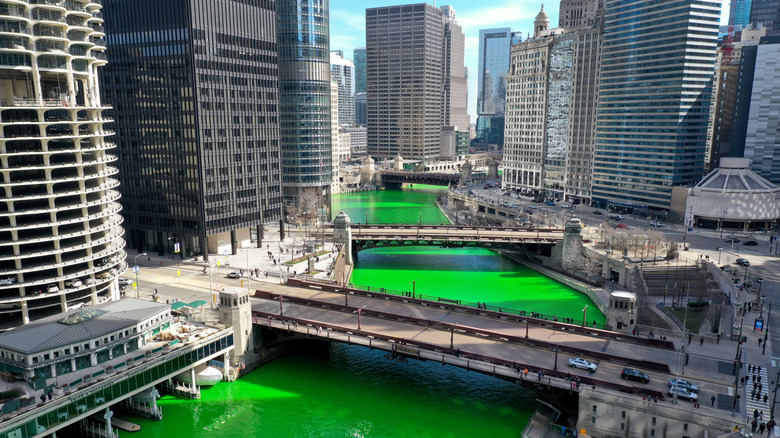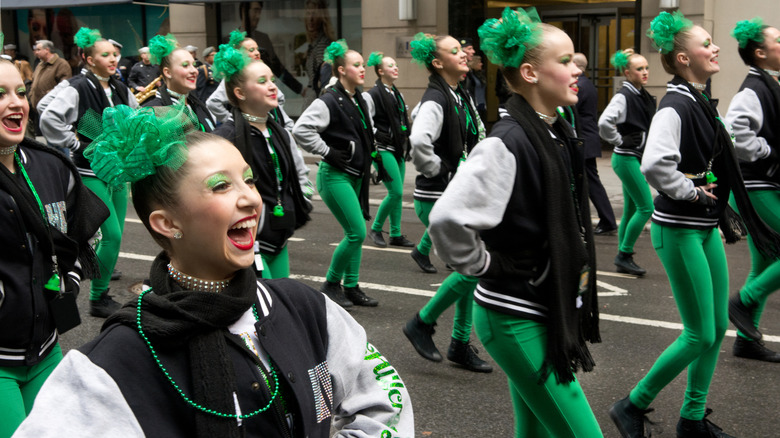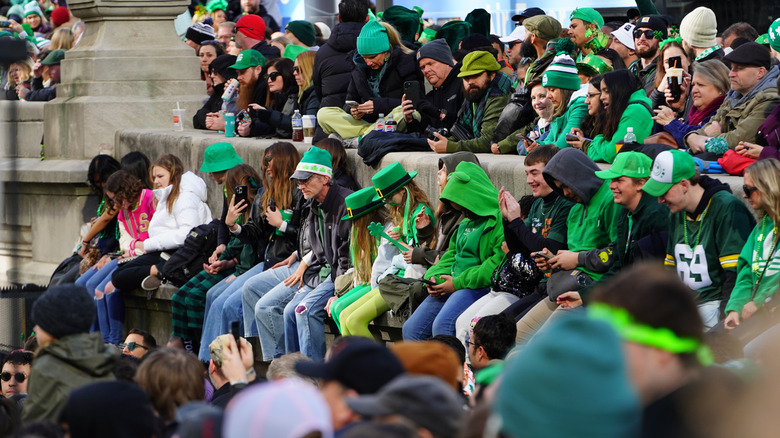The Secret Behind Chicago's St. Patrick's Day Green River Tradition
We may receive a commission on purchases made from links.
It's fun to imagine there's a mystical connection between St. Patrick's Day and the Chicago River turning green every year in mid-March — something involving magical leprechauns and enchanting fairies — but the actual process is much more straightforward. Since 1962, members of the Chicago Journeymen Plumbers Local Union 130 have taken on the task of temporarily dyeing the river, and it's not a clandestine operation. The transition is usually accomplished on the Saturday before St. Patrick's Day. Union members navigate two boats along a quarter-mile expanse of the river between Columbus Drive and State Street. The lead boat drops the dye into the water, the second boat stirs it up.
The process of dying the river has become a spectacle in its own right, drawing thousands of onlookers who vie for a prime public spot along the river to view the annual event. Favored viewing locations include the steps along the Chicago Riverwalk and the Columbus Drive Bridge — both underrated tourist attractions for your Chicago bucket list. The process usually begins at about 10 a.m. and takes approximately an hour to complete. Word to the wise: Find your spot early if you're intent on watching the boats drop the dye. Prime viewing locations fill up fast. The good news is the color fades gradually, so water will stay green for a day or more. That leaves plenty of time to snap a few well-placed pics after the crowd disperses. And if being smack-dab in the middle of the action isn't your thing, plenty of venues along the river — including a number of rooftop spots — host ticketed viewing parties. Bring your binoculars and get a birds-eye view of the action.
Why is St. Patrick's Day such a big deal in Chicago?
Clearly, the people of Chicago take their St. Patrick's Day celebrations seriously — and with good reason. Like Boston, New York, and Philadelphia, Chicago experienced an influx of Irish immigration in the mid-1800s. Following a marked uptick in the number of Irish immigrants settling in and around Chicago in the 1830s, arrivals continued to escalate well into the 19th century as people facing uncertain futures due to economic and societal hardships related to the Great Famine sought refuge with family and friends who had already settled in the Chicago area. Their timing was fortuitous. Unlike the long-established cities of Boston, New York, and Philadelphia, Chicago was just beginning to come into its own — it wasn't even incorporated until 1837. The emerging infrastructure paved the way for newly arrived Irish immigrants to stake an early claim to positions of influence in the realms of business and politics, including a string of 12 Irish mayors with a combined tenure of 80 years. One of them, Mayor Richard J. Daley, who served from 1955 to 1976, was the leading force in the effort to celebrate St. Patrick's Day with a tinted waterway — but Daley had his sights set on a different location, Lake Michigan.
The prospect of turning Lake Michigan, or even a portion of it, green for St. Patrick's Day proved a challenge, but Daley kept the idea on the back burner. Then a coincidence turned his attention to the Chicago River. Along with many U.S. cities in the mid-20th century, Chicago was just beginning to recognize the toll pollution and dumping had taken on its water resources. To stem the tide of untreated sewage flowing into the river, the city identified leakage sites by trickling green tracer dye into sewers so workers could follow the flow.
The ah-ha moment that spawned a tradition
A plan began to come together in 1961 when one of the workers on the project returned to the office with green stains all over his white overalls after a day spent dropping dye into the city's sewers. Stephen Bailey, the then-business manager of the Chicago Journeymen Plumbers Local 130, noticed the green spots and had a lightbulb moment. Bailey, who just happened to be a childhood friend of Mayor Daley and chairman of Chicago's St. Patrick's Day Parade planning committee, proposed treating a segment of the river with the same dye. And the rest, as they say, is history. The now-annual tradition began in 1962 when workers from the plumbers' union dumped 100 pounds of the same dye used to locate sewage leaks into the river. The amount of dye dumped into the river on the first go-'round proved a bit excessive — the river stayed green for an entire week. Plus, it was an oil-based fluorescein dye which, it turns out, is far from being an environmentally friendly means of getting the job done.
Early environmentalists took note and pressured the powers that be to develop a safe alternative. While the exact formula used today is a well-kept secret, we do know the current practice involves dumping about 40 pounds of a specially formulated plant-based dye into the river. Environmental protectionists still have objections to the spectacle, but the City of Chicago stands behind the current formula and insists it does not pose a risk to the river and its environs and the EPA backs that assertion. By the way, Chicago isn't the only U.S. city that dyes its rivers green for St. Patrick's Day. San Antonio, Texas and Tampa, Florida are among at least a half dozen cities that celebrate in a similar manner.


